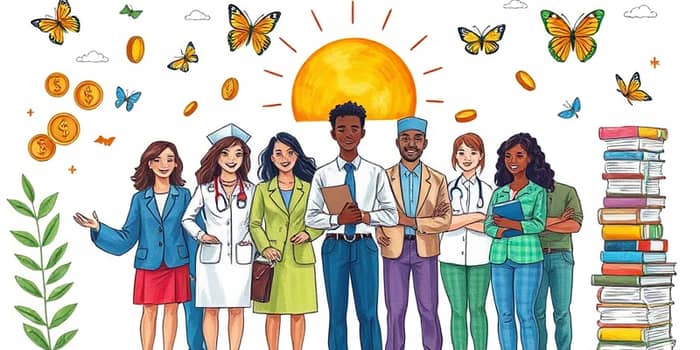Navigating the maze of student debt can feel overwhelming, but the United States offers multiple paths to relief through various forgiveness programs. Whether you serve your community, teach in a low-income district, or struggle to make ends meet, there’s a program designed to ease your financial burden over time. This guide will walk you through each major option, eligibility criteria, and practical steps to maximize your chance of forgiveness.
Overview of Student Loan Forgiveness Programs
Student loan forgiveness programs aim to relieve borrowers from outstanding debt after meeting specific requirements. These programs often target public servants, teachers, nurses, and other professionals who commit to serving underserved communities.
Key objectives include:
- Alleviating financial stress for public service employees
- Offering targeted relief to educators and healthcare workers
- Providing income-based options for borrowers with limited earnings
Public Service Loan Forgiveness (PSLF)
The Public Service Loan Forgiveness program rewards individuals who dedicate their careers to government agencies or qualifying non-profit organizations. After fulfilling the requirements, you can receive tax-free forgiveness after ten years of service.
Eligibility criteria include:
- Full-time employment with a government entity or 501(c)(3) non-profit organization
- 120 qualifying monthly payments made under an Income-Driven Repayment (IDR) plan
- Loans must be federal Direct Loans; other federal loans can become eligible through consolidation
To apply, use the PSLF Help Tool on studentaid.gov to certify your employment each year. Stay proactive by submitting the Employment Certification Form whenever you switch employers.
Income-Driven Repayment (IDR) Plans
IDR plans adjust your monthly payment amount based on your discretionary income. These plans ensure payments remain affordable and eventually lead to forgiveness.
Options include:
- Income-Based Repayment (IBR)
- Income-Contingent Repayment (ICR)
- Pay As You Earn (PAYE)
- Revised Pay As You Earn (REPAYE)
Borrowers pay a percentage of their income—sometimes as low as $0 per month—and receive forgiveness after 20 or 25 years of qualifying payments. To enroll, submit an application on studentaid.gov and recertify your income and family size annually.
Teacher Loan Forgiveness
Teachers who work in low-income schools for five consecutive years can qualify for forgiveness of up to $17,500. This program specifically rewards those who invest in underserved communities.
To be eligible, you must:
- Work full-time for five consecutive years at a qualifying low-income elementary or secondary school
- Hold federal Direct or Stafford Loans (FFEL and Perkins Loans are not eligible)
After completing the service period, contact your loan servicer to apply. Your school must certify your employment history for approval.
Perkins Loan Cancellation
Perkins Loans offer cancellation benefits for borrowers in specific public service professions, including teaching, nursing, law enforcement, and the military.
Cancellation percentages vary by profession and years of service, often reaching full cancellation after five years:
Apply through your school’s financial aid office or the Perkins Loan servicer. Be prepared to submit documentation of your qualifying service each year.
NURSE Corps Loan Repayment Program
The NURSE Corps repays up to 85% of unpaid nursing education debt for nurses working in critical shortage facilities. This program addresses healthcare inequities by incentivizing nursing talent in underserved areas.
To qualify, you must:
- Be a licensed nurse in an eligible healthcare facility
- Commit to a two- to three-year service period in an underserved location
Applications open annually; apply via the program’s Customer Service Portal. Award decisions consider financial need and facility shortage level.
Other Forgiveness Programs
Recent policy changes have introduced additional relief options. President Biden’s plan offers one-time forgiveness of up to $20,000 for borrowers meeting income thresholds.
Temporary expansions to PSLF, like the Temporary Expanded PSLF (TEPSLF), provide relief to borrowers previously deemed ineligible due to payment plan mismatches.
General Application Process
Regardless of the program, you’ll need to gather key documentation and follow these steps:
- Create and maintain a FSA ID for loan access
- Collect financial and personal information, including spouse details if married
- Submit program-specific applications and certification forms on time
For FFEL or Perkins Loans targeting PSLF, complete a Direct Consolidation Loan application to convert your loans into eligible Direct Loans.
Financial Benefits and Tax Implications
Most federal forgiveness—such as PSLF and IDR—remains tax-free under the American Rescue Plan through 2025. This provision prevents borrowers from facing an unexpected tax bill upon forgiveness. Always confirm current tax rules with a qualified advisor before filing.
Conclusion
Student loan forgiveness programs offer a lifeline to borrowers who serve their communities or face long-term financial hardship. By understanding each program’s requirements—whether it’s 120 qualifying payments under PSLF, five years of teaching in a low-income school, or service in a critical shortage healthcare facility—you can chart a clear path to debt relief.
Stay organized: maintain employment certifications, recertify incomes on time, and document every step. With persistence and the right information, you can achieve meaningful relief from student debt and focus on building a secure financial future.
References
- https://studentaid.gov/manage-loans/forgiveness-cancellation
- https://studentaid.gov/pslf/
- https://studentaid.gov/help-center/answers/article/how-to-apply-for-pslf
- https://www.nerdwallet.com/article/loans/student-loans/student-loan-forgiveness
- https://www.laurelroad.com/student-loan-forgiveness/how-to-apply-for-student-loan-forgiveness/
- https://www.consumerfinance.gov/paying-for-college/student-loan-forgiveness/
- https://www.cbsnews.com/news/student-loan-forgiveness-application-biden-relief-plan/
- https://www.laurelroad.com/student-loan-forgiveness/how-to-get-student-loan-forgiveness/










